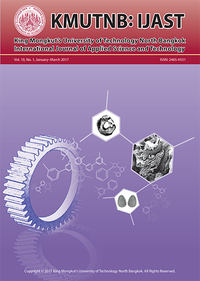Effect of Injection Flow on Conductive Network in Polypropylene-carbon-filler Composite Bipolar Plates
Main Article Content
Abstract
Bipolar plates have been manufactured by different techniques, such as high performance drilling, compression molding, metal stamping, and injection molding processes. The bipolar plates should be produced via a standard mass production technique in a one-step process, since this can reduce the cost structure of fuel cell stacks, significantly contributed by the bipolar plates. Polypropylene/three-carbon-filler composites were selected for bipolar plate production through an injection molding process for this research work. Although the conductive injection moldable composites can be produced for a bipolar plate application, their electrical conductivity, especially through plane conductivity, has not yet achieved a commercial target. For that reason, a simulation of fiber orientation in an injecting plaque using the finite element simulation program Moldex 3D was carried out with the support of Compuplast Canada Inc. to investigate the effect of an injection flow on fiber orientation in conductive networks. Even the simulation output cannot clearly elucidate the orientation of carbon fibers in the composites containing hybrid fillers as the experimental results showed. Further improvements in the development of conductive networks in injected composite bipolar plates can be achieved, for example, through tailoring of a particular injection mold geometry for the bipolar plate production.


